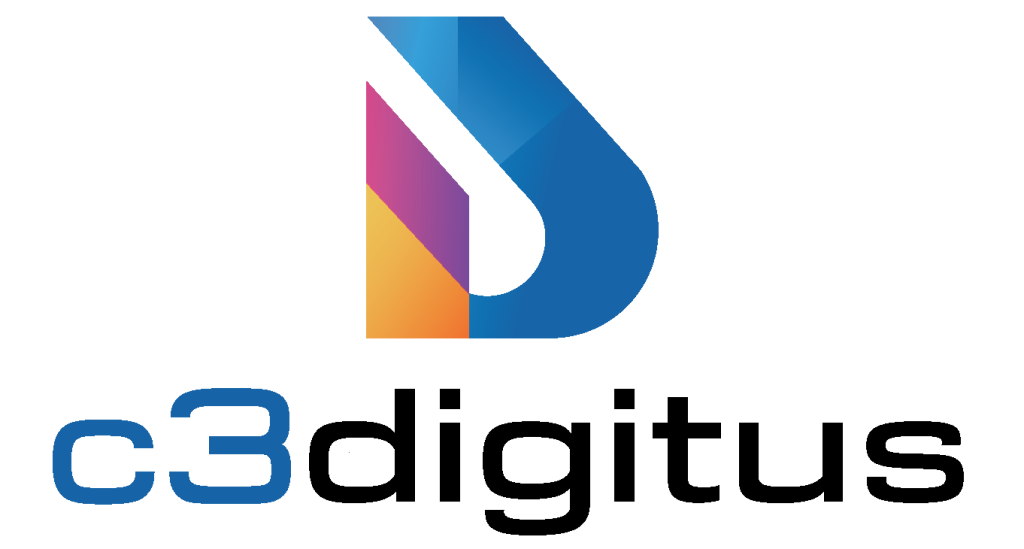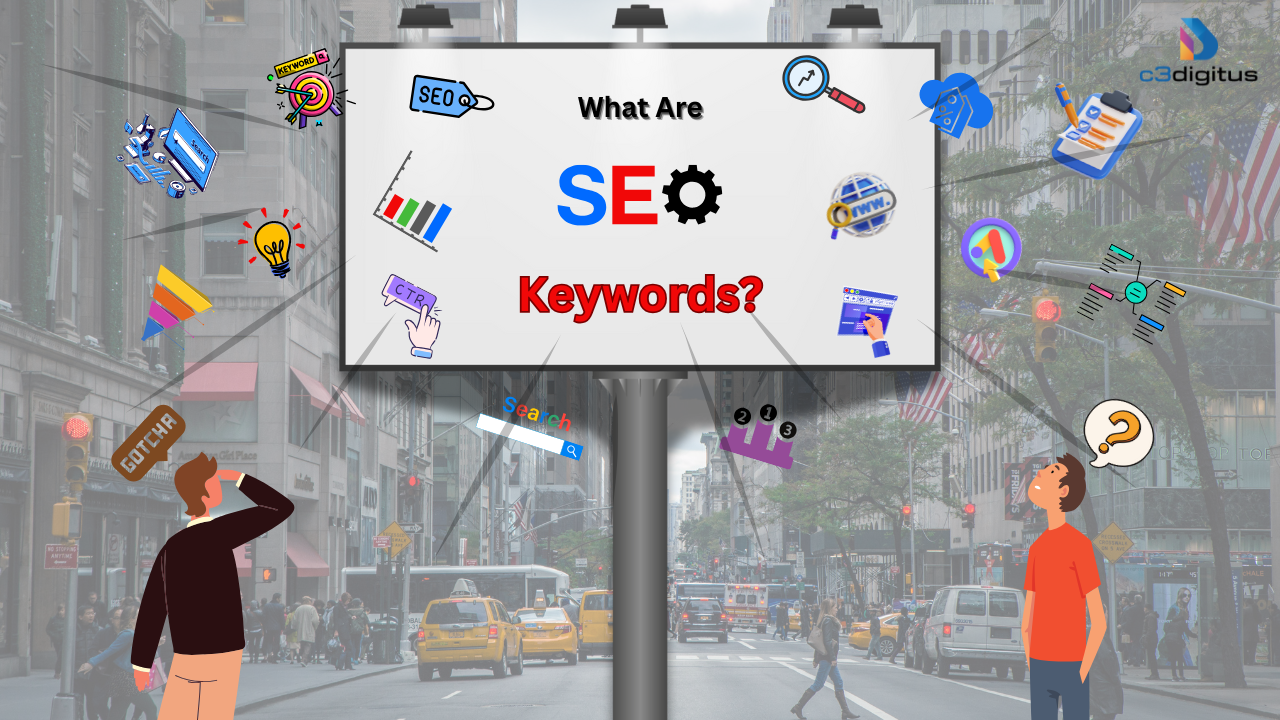Keywords are not mere individual words; rather, they are the very building blocks of search engine optimization, which is popularly referred to as SEO. In this comprehensive and very hands-on tutorial, we are going to thoroughly analyze every aspect you need to know about SEO keywords as we progress towards the year 2025, from types and research techniques to tools, search intent, clustering, tracking, and advanced usage strategies that apply to both on-page and off-page SEO.
1. What is an SEO Keyword?
An SEO keyword is any word or phrase a user types into Google (or another search engine) to find information. For marketers, keywords represent the bridge between user intent and website content.
But don’t just think of them as “words”; they’re the language of searchers, and understanding that language is how you attract the right audience.
To make your content truly searchable, you must understand how search engines crawl and index content and how keywords signal topic relevance.
Common Misunderstandings About Keywords
Many beginners think keywords are just “tags” or “terms” you sprinkle in content. But in reality, SEO keywords are used to structure entire content strategies, from content calendar planning to URL slugs to anchor text in your internal linking system.
If you’re confused between SEO keywords vs PPC keywords, this Google Ads help doc explains how match types and bidding differ from organic strategies.
2. Why Are Keywords Still Crucial in 2025?
Keywords are still crucial even with AI-powered search engines like Google’s SGE and RankBrain. They make it easier for search engines to comprehend your content and match it with relevant search terms. Additionally, keywords influence the layout of your page and how it appears in search results.
Here’s how they’re still used:
- Page Titles: A title like “Best Google Analytics Alternatives in 2025” helps Google know exactly what the page offers and matches it to users searching for that phrase.
- Meta Descriptions: Descriptions that include search terms like “free keyword research tools” are more likely to match a user’s query and increase clicks.
- Headings: Subheadings like “How to Use Google Keyword Planner” clearly break down topics and improve both user experience and SEO.
- URLs: Google-friendly URLs such as https://ads.google.com/home/tools/keyword-planner/
tell users and search engines exactly what the page is about, compared to vague or numeric links.
Even in 2025, keywords still shape how your content is found, understood, and ranked. They remain a core part of any strong SEO strategy.
Also, check out our guide on What is E-E-A-T? and Technical SEO Basics.
Keywords and E-E-A-T (Experience, Expertise, Authoritativeness, Trustworthiness)
Google’s quality rater guidelines have leaned heavily on topical relevance and trust signals. Well-chosen keywords ensure your content demonstrates expertise on a topic. Learn more about this concept in Google’s Search Quality Guidelines.
3. Understanding Keyword Intent
Every time someone types something into Google, there’s a reason behind it. Maybe they want to learn something. Maybe they’re looking for a specific website. Or maybe they’re ready to buy.
That reason is called search intent, and if you understand it, you can create content that gets found and gets clicks.
There are four main types of search intent. Let’s break them down one by one, with simple examples.
1. Informational Intent
“The user wants to learn something.”
This is when someone is searching because they have a question or want to understand something better. They’re not trying to buy anything yet — they’re just doing research.
Examples:
- “How does AI writing work?”
- “What is SEO?”
- “Tips to sleep better”
They want helpful answers, not sales pages.
Best content for this:
- Blog posts
- Step-by-step guides
- Educational videos
Simple tip: Focus on giving clear, useful answers. The easier it is to understand, the better.
2. Navigational Intent
“The user is trying to find a specific website or brand.”
Here, people already know where they want to go. They just use Google to get there faster instead of typing the full URL.
Examples:
- “LinkedIn login”
- “Netflix homepage”
- “Grammarly pricing page”
They’re not looking for suggestions — they already know what they want.
Best content for this:
- Your homepage
- Pages with your brand name in the title
- Easy-to-find landing pages
Simple tip: Make sure your website is easy to find when people search for your name or product.
3. Transactional Intent
“The user is ready to buy or take action.”
This is when people have made up their minds. They’ve done the research, and now they’re ready to purchase, sign up, or download.
Examples:
- “Buy pickleball paddle online”
- “Sign up for AI writing tool”
- “Get 20% off Canva Pro”
These people are serious and ready to go.
Best content for this:
- Product pages
- Landing pages with special offers
- Strong call-to-action buttons (like “Buy Now” or “Get Started”)
Simple tip: Make it super easy for them to take the next step. No distractions, just clear info and a fast checkout.
4. Commercial Investigation Intent
“The user is comparing options before they decide.”
These people are planning to buy soon, but they want to choose the right product or service. So they’re reading reviews, comparing brands, or looking for top recommendations.
Examples:
- “Best AI tools for content writing”
- “Asana vs Trello”
- “Top 5 pickleball paddles 2025”
They’re close to converting, but they still need a little help deciding.
Best content for this:
- Side-by-side comparisons
- Review blog posts
- “Best of” product lists
Simple tip: Be honest. Show pros and cons, and explain what makes your product or service better.
Why This Matters for Your Website
If you want your content to show up on Google — and bring in the right kind of traffic — you need to understand what your audience is looking for.
When your content matches what people want:
- It ranks higher
- People stay on your site longer
- You get more leads and sales
Ahrefs explains search intent in depth and how misaligned intent leads to poor ranking.Knowing the intent ensures you’re not trying to rank a blog post for a keyword that requires a product page, or vice versa.
Keywords should align with what your target audience is looking for. Determine whether users are searching to learn (informational), make a purchase (transactional), or find a specific site (navigational).

How to Identify Intent from the SERP?
Open a private/incognito browser and search for your keyword. Analyze the top 5 organic results:
- Are they blog posts, landing pages, or ecommerce listings?
- Is there a People Also Ask box?
- Do you see product carousels or featured snippets?
These clues tell you what Google believes the correct format is for that keyword.
4. Types of SEO Keywords
Not all keywords are the same. People search differently based on what they need, and as a content creator or marketer, it’s your job to match their language. Here’s a breakdown of the main keyword types, what they mean, and how they help with SEO:
1. Short-Tail Keywords
Short-tail keywords are very general search terms consisting of a single word or two. They receive a high volume of searches each month, but tend to be too broad to sell well. Individuals searching with them are typically at the beginning of their search process and not ready to buy just yet.
Examples:
- shoes
- fitness
- digital marketing
Use these as keywords that give you traffic but not necessarily clicks and sales.
2. Long-Tail Keywords
Long-tail keywords are longer, more descriptive phrases. They’re used by individuals who precisely know what they’re searching for, which implies they will click, purchase, or enroll more likely. They’re less competitive and ideal for targeting niche groups.
Examples:
- white leather sneakers for women
- Best project management tool for freelancers
- How to cook vegan lasagna
These are perfect if you’re trying to appeal to high-intent customers and generate conversions.
Relevant Blog: Long Tail Keywords vs Short Tail Keywords: What’s the Difference?
3. LSI (Latent Semantic Indexing) Keywords
These are terms or phrases highly related to your central theme. They assist Google in knowing the meaning of your content better, which can improve your rankings. LSI keywords aren’t synonyms — they simply naturally occur in text near the main keyword.
Examples (for a blog about “running shoes”):
- cushioning
- laces
- arch support
- marathon training
Use them to create well-rounded, on-topic content that sounds natural and informative.
4. Branded Keywords
These are specific company, product, or service names. Individuals looking for branded terms are already familiar with the brand and hence more likely to trust and use it.
Examples:
- Nike Air Max
- Canva Pro features
- HubSpot CRM pricing
These keywords tend to demonstrate buying intent and are good for brand awareness as well as conversions.
5. Competitor Keywords
These are keywords that reference your competitors. Individuals searching these terms are comparing products or seeking alternatives. You can use them to develop comparison content or to frame your product as a superior alternative.
Examples:
- Ahrefs vs SEMrush
- Mailchimp alternatives
- Shopify vs WooCommerce
It’s an intelligent way to target users who are ready to decide but have not yet chosen a brand.
6. Geo-Targeted Keywords
These are location-based and utilized by individuals searching for services, businesses, or events local to them. If you’re a local business or specifying a local area, these are critical.
Examples:
- best restaurant in Boston
- SEO firm in Chicago
- yoga classes local to me
Excellent for local SEO — particularly if your aim is foot traffic or local customers.
7. Question-Based Keywords
These are entire questions that individuals input in search engines when they are looking for a straightforward answer. They’re ideal for blog posts, FAQs, and voice search targeting.
Examples:
- What is SEO?
- How do I get on Google?
- Why is my site taking so long to load?
These keywords are ideal for appearing in featured snippets and luring curious users.
Want to get deeper into keyword types? This cheat sheet might help more –

5. How to Do Keyword Research (Step-by-Step)?
Step 1: Start with Seed Topics
List what you offer, who you serve, and what problems you solve.
Example: An e-commerce SEO agency might target “technical SEO audit,” “Shopify SEO expert,” and “best keywords for product pages.”
Step 2: Use Keyword Tools
- Google Keyword Planner
- Ahrefs Keywords Explorer
- Semrush Keyword Overview
- Ubersuggest by Neil Patel
- AnswerThePublic
These tools reveal keywords your audience searches.
Step 3: Analyze Search Volume, KD, and CPC
But, How? Go to any tool suggested above and just add your keyword or list.
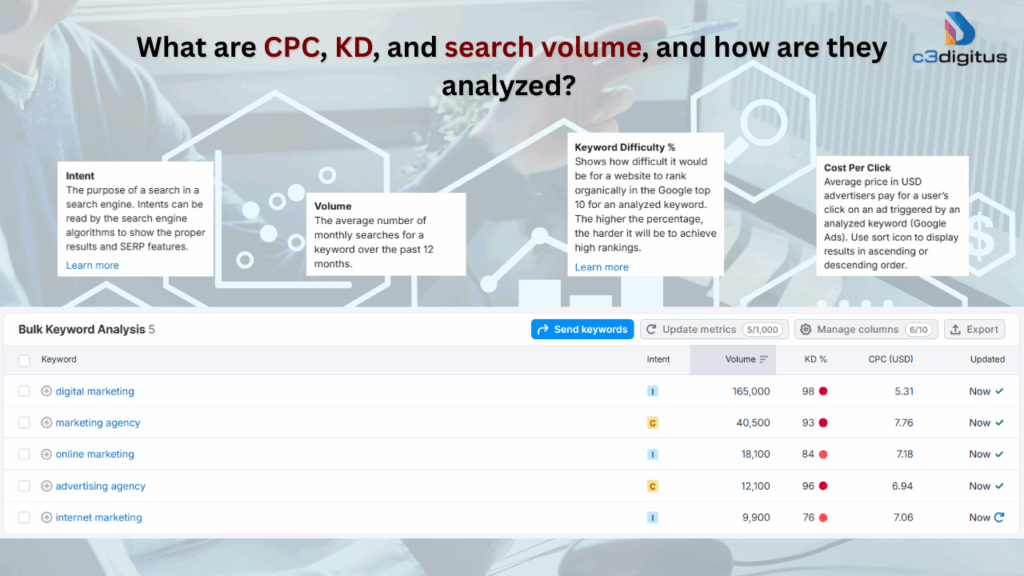
Then, create a keyword sheet that logs:
- Search Volume
- Keyword Difficulty
- CPC
- Intent (Informational, Navigational, etc.)
- Suggested Content Type (Blog, Page, FAQ)
Use Moz Keyword Explorer to estimate competition levels and Google Trends to compare seasonal patterns.
Step 4: Map Keywords to Content
Every keyword should be paired with a content type:
- “How to” → Blog post
- “buy” → Product page.
- “best + [industry]” → Comparison blog
- “location + service” → Landing page
Step 5: Check SERP Features
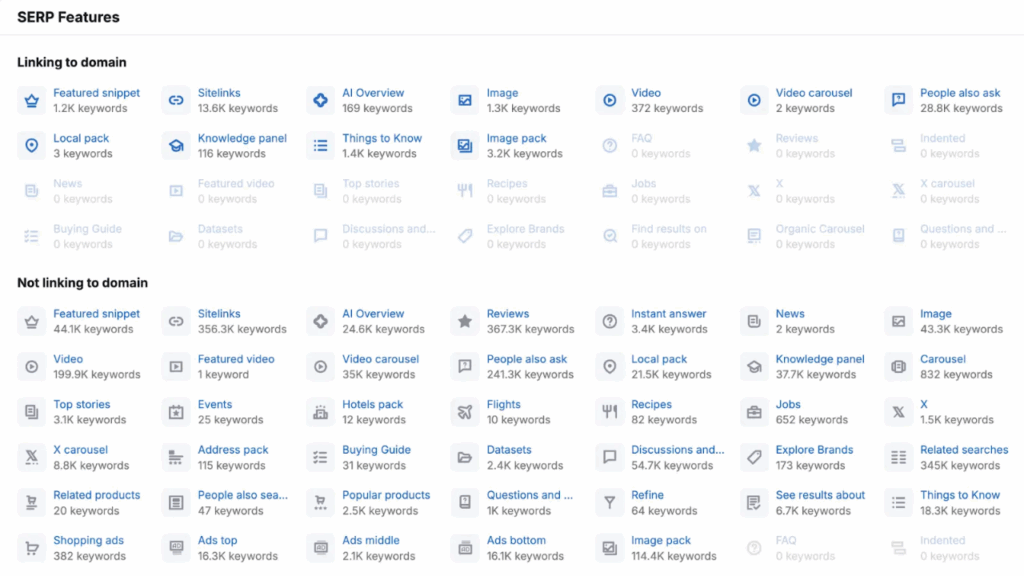
Look at what currently ranks for your target keyword. Are there featured snippets, image packs, “People Also Ask” boxes, or video results? These clues help you tailor your content format.
Tools like Mangools SERP Checker or simply Googling in incognito mode help identify these elements.
6. Keyword Clustering: Smarter SEO Scaling
Keyword clustering lets you target a topic, not just a term. It enhances topical authority and allows one post to rank for dozens of variations.
Example Cluster: “b2b seo strategy”
- enterprise seo framework
- lead gen seo for b2b
- b2b content marketing keywords
Tools to cluster keywords:
Pro Tip: Use AI to Speed Up Clustering
You can now use tools like ChatGPT or Claude to help you sort keyword lists into logical topic groups. Just paste your keyword export and ask for clustering based on shared themes or intents.
7. Keyword Tracking & Updating
Once content is live, track your keyword performance monthly using:
Update older pages when:
- Rankings drop for priority keywords
- New intent or competitors appear.
- Search patterns shift seasonally.
Don’t Forget About Keyword Cannibalization
Over time, multiple pages might rank for the same keyword, hurting both. Use Search Console to detect overlap and consolidate content when needed.
8. Bonus Tips for Using Keywords in Content
- Use primary keywords in the H1, intro, slug, and meta description.
- LSI keywords in subheadings and paragraph variations.
- Alt-text for images should reflect topical terms.
- Use keywords naturally in the URL and anchor links.
Leverage Internal Linking with Keyword Anchors
When linking between blogs or pages, use partial match anchor text (e.g., “learn SEO keyword strategy” rather than “click here”) to give Google extra semantic signals.
Keyword Density & Semantic SEO
Keyword stuffing doesn’t work anymore. Search engines are smarter now and care more about how well your content covers a topic, not how many times a keyword appears. That’s where semantic SEO comes in. It’s about using related terms, questions, and subtopics that naturally support your main keyword.
For example, if your main keyword is Google Analytics tips, your content shouldn’t just repeat that phrase.
Instead, it should also include related ideas like how to set up GA4, ways to track website traffic, using Google Tag Manager, or setting up event tracking. These related terms help Google understand that your content is in-depth and useful.
Avoid keyword stuffing. Focus on semantic coverage. Tools like Surfer SEO or MarketMuse can show you what subtopics and variations you’re missing in your draft.
9. Mistakes to Avoid in Keyword Strategy
- Targeting keywords without matching SERP intent
- Ignoring featured snippet and People Also Ask opportunities.
- Over-prioritizing volume vs. conversion
- Failing to update old content with fresher queries
See Search Engine Journal’s SEO Mistakes List for examples.
10. Additional Insights & Expert Advice
Use Keywords in Schema Markup
Structured data using Schema.org helps reinforce your page’s topic. For blogs, use Article or BlogPosting schema and inject your main keyword into the headline, description, and about property.
Build Keyword Personas
Instead of just targeting terms, build user personas: Who is searching for these terms? What’s their problem, urgency, or purchase intent? This humanizes your keyword choices.
Don’t Ignore Zero-Volume Keywords
These are low-competition gems, especially for B2B or niche service providers.
When researching, if you find a keyword that has low search volume but it aligns with your audience and your service offering, then it’s a hidden opportunity. Claim it before your competitors.
11. Difference Between SEO Keywords and PPC Keywords
While SEO and PPC keywords often overlap, how they’re used — and how they’re prioritized — is very different.
SEO keywords are used for organic rankings. Your goal is to align content with search intent, build topical authority, and earn long-term traffic without paying per click. The emphasis is on:
- Relevance and quality
- User engagement and retention
- Long-term content investment
PPC keywords, on the other hand, are for paid ads like Google Ads. You bid on them and only pay when someone clicks. With PPC:
- You need immediate visibility
- You can test multiple ad creatives quickly
ROI is tracked via conversions and cost-per-click (CPC)
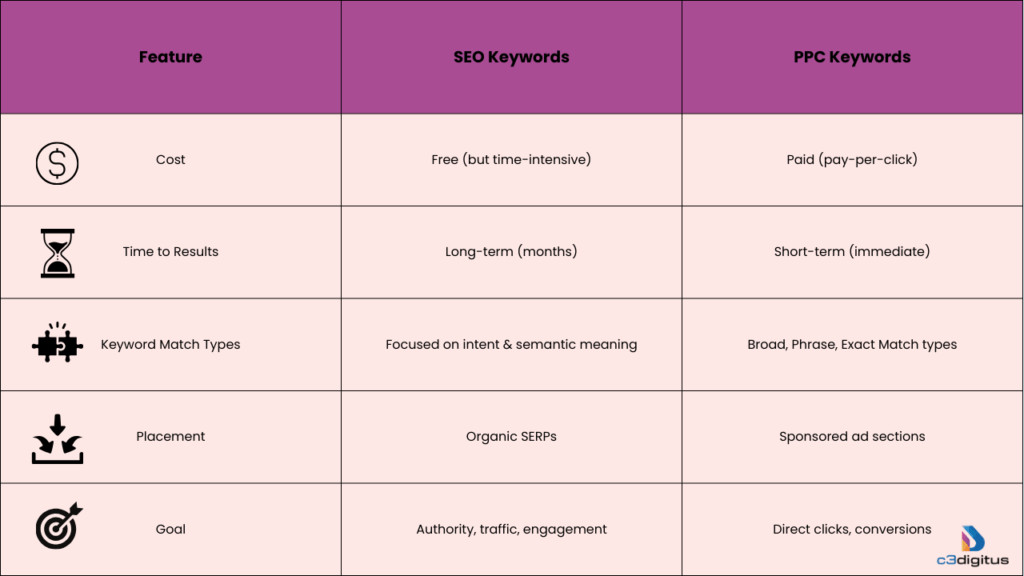
Tip: Use SEO for sustainable growth. Use PPC for quick wins, product launches, or time-sensitive campaigns.
12. Best Keyword Research Tools
When it comes to creating a smart keyword strategy in 2025, your tools make a difference. There is no “perfect” tool, but each of the ones listed below shines in some respect, whether just launching or expanding an advanced SEO program.

Pro Tip: Begin with Google Keyword Planner for free data, then confirm with Ahrefs or SEMrush to craft a solid plan.
You can also use Keyword Insights for grouping by theme or intent, and ChatGPT for clustering exploratory keywords.
13. Summary + Next Steps
SEO keywords are still your best long-term organic traffic bet if you understand their depth. They’re not a checkbox; they’re the map to relevance, reach, and ROI.
What to do next:
- Brainstorm seed terms for your audience
- Build your keyword sheet
- Map each one to a content asset
- Create clusters
- Track. Test. Update.
Ready to build traffic the strategic way? Bookmark this complete SEO keyword guide and revisit it every time you plan a new blog, landing page, or campaign.
